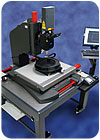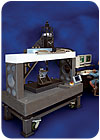
Special optical systems such as this one can be engineered to create multiple views of a part. Source: Starrett Kinemetric Engineering Division
Most manufacturers feel increasing pressure to introduce enhanced new products with ever-narrower time-to-market windows. A demanding marketplace is driving new measuring technology solutions to meet product engineering and production challenges.
Custom optical metrology systems have become a popular solution for demanding measurement and inspection requirements. Large and small manufacturers have experienced fast returns on the investment in time and capital necessary to find a supplier, determine an effective design and implement an optical measuring system that has been engineered and built for their specific requirements. Diligent management throughout the project, from conception to implementation, will reduce risks and ultimately provide satisfactory results.
A custom optical inspection machine can be defined as a system that has been designed and built to perform a specific measuring task for which it has been determined there is not a suitable standard product available. The scope of such a project can range from low-cost enhancements to standard optical metrology systems to extensive engineering projects involving custom hardware and software.
Even relatively small projects can seem overwhelming to the prospective operator who thinks that a custom project might be the solution but has not had experience with such a project. However, suppliers of custom metrology systems can work with manufacturers to design and build custom systems. To ensure a successful result, suppliers recommend that manufacturers use a phased approach to every project with careful implementation of each phase.
Phase I: Defining Needs
Manufacturers should start with the appointment of a project leader. This is a person who ideally has project experience, an engineering perspective and a strong knowledge of the processes that will be the focus of the project. A familiarity with optical systems and measurement technology may be an additional requirement depending on the scope of the project.The project begins with an assessment of the goals that result in creating a foundation for all of the project phases that follow. This is simply an outline of what a potential supplier will need to know. It should include the key system requirements such as throughput, accuracy, repeatability and other considerations including space needed and environmental conditions.
A requirement such as operators with limited computer experience and a maximum of two hours training will be able to successfully use the system is an example of other information that may be a design consideration.
The next step is to research what is available as an off-the-shelf solution. Because this is purely an information collection task, the most efficient method is to research available products from company Web sites. Most list fairly complete specifications online which enable manufacturers to determine if a standard product is a viable option, or at least weed out all but the potential suppliers.
If manufacturers suspect some standard product suppliers might have a product that conforms to their needs, the next step should be a phone interview. In the interview, it should be made clear to the potential supplier that this is the process of determining if a standard or custom product solution is best for the application. Requesting a budgetary price range on any potentially suitable product models is reasonable at this point.
At this stage manufacturers should have enough primary information to determine if a custom solution or standard product is the best option. If it is clearly a custom solution, it is time to move on to Phase II.

A custom engineered, high magnification, high accuracy, automated system is used in the electronics industry. Source: Starrett Kinemetric Engineering Division
Phase II: Finding a Supplier
Determining a reliable supplier is critical to the success of the project. With the information collected in the needs assessment phase, manufacturers will have an informed position on the scope of the project. This helps establish a fit between requirements and a custom optical metrology systems supplier.When selecting potential suppliers, examine knowledge, experience and reputation. During the assessment process, customers will have additional criteria specific to their application which should be weighted for importance. An objective supplier evaluation can become complex and time consuming, however the effort is warranted. Making a good supplier choice is the single most important decision in the entire project.
At this point a preferred supplier may be obvious; in any case, the field should be narrowed to no more than two or three candidates. In the final selection process, manufacturers should meet with each potential supplier to:
The last item in the list above should be weighted heavily during final assessment. It might be helpful for manufacturers to develop a list of questions that would serve as a reference point for each interview. These are questions used to evaluate how the potential supplier responded to key matters such as:
From the potential supplier interviews manufacturers should have an idea of what the system will cost. At this point, a preliminary budget would be useful in starting to address the financial aspects of the project.
Phase III: Design and Contract Process
After a supplier has been selected, the focus becomes system design. This process may involve several meetings with the supplier and is usually an iterative process. The supplier will suggest initial design concepts based on their knowledge and experience. The works accomplished in Phase I will be useful now as the objectives carefully determined in the initial needs assessment become the foundation for the design criteria.In this phase, and for the remainder of the project, the key is a functional working relationship between the supplier and customer. Both must hold a clear, well-understood vision as to project objectives and implementation.
As much as possible, the final quotation document should outline all critical aspects of the project such as:
The quotation is a critical document and once signed by both parties should leave no doubt as to the outcome of the project. However, it would be impractical to include minute details on every aspect of the project. On most projects it becomes necessary to trust the builder to follow basic conventions considered good practice.

Custom optical systems range in size from small benchtop systems to very large floor models such as the multiaxis granite measuring system. Source: Starrett Kinemetric Engineering Division
Phase IV: Contract Acceptance
After there is a thorough understanding of the quotation and resultant meeting of the minds, it is time to issue a purchase order and get started. This may take more than one supplier/customer meeting. It is imperative that all issues of contention be completely resolved.Given a competent supplier choice and good project management, the purchase of a custom optical metrology system will yield a fast return on investment with minimized risk in the key factors established:
Tech Tips
Quality Online
For more information on optical measurement, visit www.qualitymag.com to read these articles:- “Be Precise with Optical Measurement”
- “Defining Optical Measurement”
- “Sorting Through Optical Options”